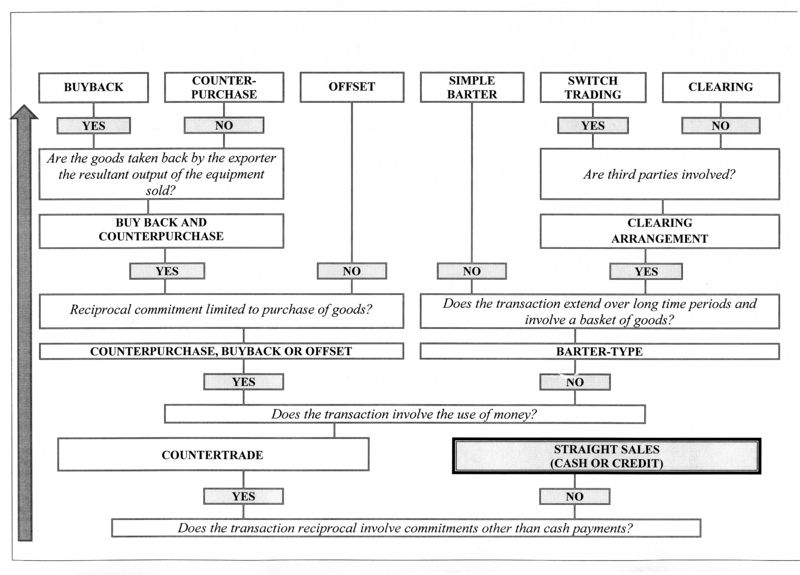Countertrading
From Supply Chain Management Encyclopedia
Russian: Встречная торговля
Introduction
Countertrade is an umbrella term covering a wide range of commercial mechanisms for reciprocal trade. It can manifest itself in several forms but always involves payment being made, at least partially, in goods or services instead of money. It often occurs when multinationals sell to a customer abroad and that customer pays by providing goods to the multinational. In some countries,countertrade is a condition of the buying organisation importing goods from elsewhere [1]. There are many forms of countertrading, ranging from simple barter agreements to complex offset deals that involve the exporter agreeing to compensatory practices with respect to the buyer. Countertrading commonly takes place between private companies in developed nations and the governments of developing countries, although countertrading also occurs between developed nations. It has become popular as a means of financing international trade to reduce risks or overcome problems associated with various national currencies[2].
Throughout history countertrading and barter [3] occurred whenever there was a shortage of money, or before money even existed. In modern times, countertrading arose as a means of conducting international trade when money was scarce, currencies couldn't be converted, or they were subject to inflationary and deflationary swings in value. In Germany between the two World Wars and after World War II, money was scarce and countertrading and barter became a way of conducting international trade. Eastern European countries followed Germany's lead and employed countertrading to overcome the problems of their own nonconvertible currencies. It was a practice that was favored by the centrally planned Eastern European economies. In the 1990s Eastern Europe and the countries of the former Soviet Union began countertrading with Western nations to overcome difficulties associated with their currencies.
Classification “Tree” of Countertrading Forms
Countertrade is inherently an ad hoc activity - practice varies according to local regulations and requirements, the nature of the goods to be exported and the current priorities of the parties involved. Also, the terms used to describe the main modes of trading vary, often interchangeably causing confusion. However, the most common forms of countertrade and the terms most usually applied are as follows[4] (from the left to the right on the Classification "Tree" above):
Buyback. Here, suppliers of capital plant or equipment agree to be paid by the future output of the investment concerned. For example exporters of equipment for a chemical plant may be repaid with part of the resulting output from the factory. This practice is most common with exports of process plant, mining equipment and similar orders. Buyback arrangements tend to be much longer term and for larger amounts than counterpurchase or barter deals.
Counterpurchase. In a counterpurchase agreement,a foreign supplier undertakes to purchase goods and services from the purchasing country as a condition of securing the order. There will be a contract for the principal supply, paid on normal cash or credit terms - and there will be a separate agreement to cover the counterpurchased goods (also bought on normal cash or credit terms). The counterpurchase agreement can vary from a general declaration oF intent, to a binding contract specifying the goods and services to be supplied, the markets in which they may be sold, and the penalties for non-performance. The value of the counterpurchase undertaking may vary in value between 10% and 100% (or more) of the original export order.
Counterpurchase is generally imposed for two reasons: first, to stimulate exports and second, to alleviate the balance of payment deficit resultinig from imported goods.
Offset. Offset has traditionally been used by governments around the world when they have made major purchases of military goods but is becoming increasingly common in other sectors. There are two distinct types:
- direct offset: here the supplier agrees to incorporate materials, components or sub-assemblies which are procured from the importing country. In some large contracts, successful bidders may be required to establish local production. Direct offset has been particularly common for trade in defence systems and aircraft.
- indirect offset: here the purchaser requires suppliers to enter into long term industrial (and other) co-operation and investment but these are unconnnected to the supply contract and may be either defense related or in the civil sector.
The overall objective of offset either direct or indirect in the defence sector is generally to promote import substitution and to minimize the balance of payments deficit for military purchases by develojiing an indigenous industrial defense capability.
The objective of stimulating civil investments is to increase, diversify and support the industrial base. These investments may be in manufacturing ventures, infrastructure, or training, and may be totally different in nature to the original sale (e.g. investment in a chipboard factory might be used to offset the sale of aeroengines).
Barter. In a barter deal, goods are exchanged for goods - the principal export is paid for with goods (or services) from the importing market. A single contract covers both flows and in the simpler case, no cash is involved. In practice, however, the supply of the principal export is often released only when the sale of the bartered goods has generated sufficient cash.
Barter is often the main means of trading in subsistence economies and in cross border trade in undeveloped regions of the world. More developed markets use it in international trade where they have commodities to offer. which are accessible to world markets. Barter may also be introduced into existing contracts to recover debts i.e. when the original payment terms have failed.
References
- ↑ Countertrade - CIPS Knowledge Works - http://www.cips.org/Documents/Resources/Knowledge%20Summary/Countertrade.pdf - accessed 05/09/2012
- ↑ Countertrading http://www.referenceforbusiness.com/encyclopedia/Cos-Des/Countertrading.html#ixzz27DpA3fwg
- ↑ Countertrading // Reference for Business: Encyclopedia of Business - http://www.referenceforbusiness.com/encyclopedia/Cos-Des/Countertrading.html#ixzz0uhqG14cn - accessed 05/08/2012
- ↑ London Countertrade Roundtable - http://www.londoncountertrade.org/countertradefaq.htm





